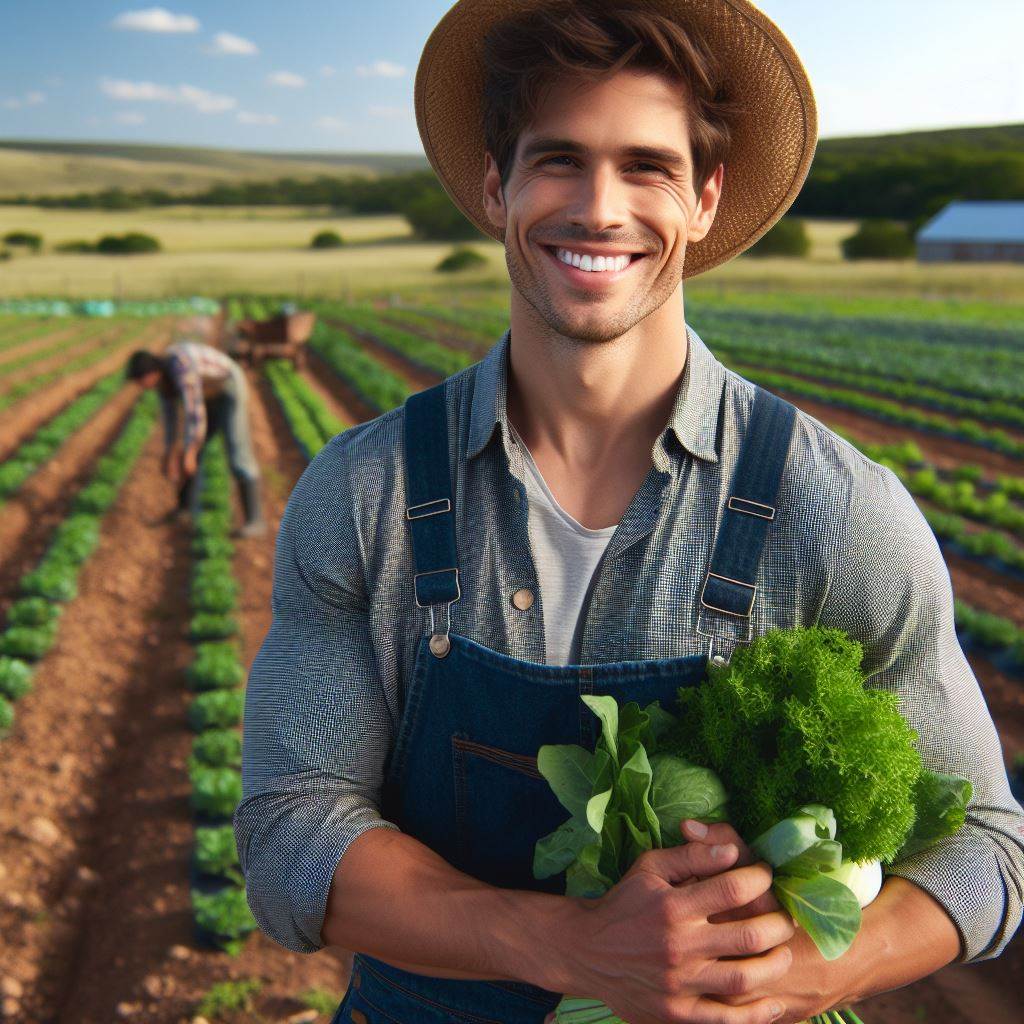Introduction
As the sun rose over the Midwest farm, the Johnson family embarked on their eco-farming journey.
The decision to embrace sustainable agriculture not only had a profound impact on their lives but also on the environment and community they called home.
In this blog post, we will explore the remarkable tale of their transition to eco-farming, examining the challenges they faced, the benefits they reaped, and the lessons they learned along the way.
Through their experiences, we will gain valuable insights into the significance of eco-farming and its potential to create a healthier, more sustainable future for all.
Join us as we delve into the Johnson family’s extraordinary journey and discover the transformative power of eco-farming.
Background on the Midwest Family
A. The Andersons are a Midwest family deeply rooted in farming for generations
The Anderson family has a rich history in farming, with each successive generation passing down their love for the land.
They have owned and operated their farm in the heart of the Midwest for over a century, relying on conventional farming practices to make a living.
For years, the Andersons embraced the use of synthetic fertilizers and pesticides, believing they were necessary to maximize crop yields and protect their crops from pests.
However, as time went on, they noticed several drawbacks to their conventional farming methods.
Firstly, the excessive use of synthetic fertilizers had detrimental effects on the soil quality.
Over time, the soil became depleted of essential nutrients, leading to decreased fertility.
Despite increasing their fertilizer use, crop yields started to stagnate and even decline.
Additionally, the Andersons became increasingly concerned about the impact of their farming practices on the environment.
They observed how chemical runoff from their fields contaminated local water sources and harmed aquatic life.
Witnessing these ecological disruptions deeply troubled the family.
Furthermore, the Andersons started having health concerns linked to their exposure to chemicals.
They discovered that their reliance on synthetic pesticides had unintended consequences for their own well-being.
Skin irritations, respiratory issues, and headaches were among the health problems they experienced.
B. Their motivations for transitioning to eco-farming
The Andersons’ growing awareness of these issues motivated them to explore alternative farming methods.
They wanted to find a way to farm that would be more sustainable, both for the environment and their own health.
After extensive research, they decided to embark on an eco-farming journey.
Eco-farming, also known as organic or regenerative farming, involves a more holistic approach to agriculture.
It prioritizes the use of natural fertilizers, crop rotation, and integrated pest management.
By embracing eco-farming, the Andersons aimed to restore the health of their soil, minimize pesticide use, and create a more resilient and diverse farming ecosystem.
Transitioning to eco-farming was no easy feat for the Andersons. It required a significant shift in their mindset and farming practices.
They had to relearn and adapt new techniques and methods, formulating organic fertilizers, and introducing beneficial insects to control pests.
However, the Andersons were determined to make this transition for the sake of their land, their health, and the generations to come.
They believed that by adopting eco-farming, they could uphold their farming traditions while building a more sustainable future.
Read: Pest Plight: Stories from the Field
The Decision to Embrace Eco-Farming
A. Factors that led the family to consider a change
- The family considered a change due to concerns about the negative impacts of conventional farming.
- They recognized the importance of sustainability and environmental responsibility in their decision-making process.
- To educate themselves, they extensively researched eco-farming practices and their potential benefits.
- They attended workshops, seminars, and conferences to further their knowledge about sustainable farming methods.
- The family also sought advice from experienced eco-farmers who shared their success stories and challenges.
- Understanding the effects of chemical pesticides, they realized the need for safer alternatives.
B. Importance of sustainability and environmental responsibility in their decision-making
- They were motivated by a desire to protect their health, the environment, and future generations.
- The excessive use of synthetic fertilizers and antibiotics in conventional farming concerned them.
- They learned about organic and permaculture farming techniques, focusing on regenerative practices.
- Soil health, water conservation, and biodiversity preservation became key considerations in their decision-making.
- Rethinking the industrial approach to agriculture, they recognized the value of sustainable farming methods.
- They discovered that eco-farming is not just a lifestyle change, but a commitment to fostering resilience.
- The concerns over food security and the global environmental crisis played a significant role in their decision.
- By embracing eco-farming, they aimed to contribute to a more sustainable and resilient food system.
- They recognized the importance of small-scale agriculture in promoting local economies and communities.
- Learning about the benefits of agroecology, they were convinced it could address various ecological issues.
- They realized that embracing eco-farming meant relearning traditional farming practices and indigenous knowledge.
- Considering the damaging effects of pesticide drift on neighboring communities, they advocated for change.
C. How they researched and educated themselves about eco-farming practices
- Through their research, they found that organic farming methods could lead to healthier soils and increased biodiversity.
- Understanding the long-term economic benefits, they were motivated to transition to sustainable practices.
- The family saw eco-farming as an opportunity to reconnect with nature and build a closer relationship with the land.
Embracing eco-farming required a comprehensive understanding of its principles and a commitment to change.
Read: Water Scarcity: A California Farmer’s Story
Adopting Eco-Friendly Farming Techniques
When it comes to eco-friendly farming, the Midwest family in our story has truly embraced the principles of sustainable agriculture.
They have implemented a variety of techniques that not only benefit the environment but also improve the overall health and productivity of their farm.
A. Use of Organic Fertilizers
- The family understands the importance of maintaining soil fertility while avoiding harmful chemicals.
- They have completely eliminated the use of synthetic fertilizers and instead rely on organic alternatives.
- These organic fertilizers, such as compost and manure, provide essential nutrients to the soils and promote healthy plant growth.
B. Natural Pest Control Methods
- Rather than resorting to chemical pesticides, the family utilizes natural pest control methods.
- They have introduced beneficial insects, like ladybugs and praying mantises, to their farm.
- These insects act as natural predators, keeping harmful pests in check and reducing the need for chemical intervention.
- The family also employs crop rotation and intercropping techniques to disrupt pest lifecycles and minimize pest pressure.
C. Integration of Crop Rotation and Cover Cropping
- Crop rotation is a standard practice on the family’s farm, and they rotate their crops annually.
- This technique helps break pest and disease cycles and reduces soil erosion.
- Additionally, they have implemented cover cropping, which involves planting a specific crop to protect and enrich the soil during the off-season.
- Cover crops act as a natural barrier against weeds, improve soil structure, and provide valuable organic matter when they are plowed back into the soil.
- By integrating crop rotation and cover cropping, the family has witnessed a significant improvement in soil health and fertility.
These eco-friendly farming techniques have not only had a positive impact on the farm’s sustainability but have also led to numerous benefits for the family.
They have seen a decrease in input costs as organic fertilizers are cheaper and readily available.
Moreover, by avoiding synthetic pesticides, they have ensured that their products are free from harmful residues, making them more attractive to consumers seeking healthier options.
Transform Your Agribusiness
Unlock your farm's potential with expert advice tailored to your needs. Get actionable steps that drive real results.
Get StartedAdopting these techniques has also allowed the family to become more resilient to climate change.
By improving soil health, the land can better retain moisture, reducing the need for excessive irrigation.
Additionally, the biodiversity fostered by natural pest control methods creates a more balanced and resilient ecosystem that can adapt to changes in weather patterns.
Transitioning to eco-friendly farming has been a transformative journey for this Midwest family.
Their commitment to sustainable practices not only preserves the environment but also secures the future of their farm for generations to come.
As they continue to refine their techniques and explore innovative approaches, they serve as an inspiration for others looking to embrace eco-friendly farming and make a positive impact on our planet.
Read: Biosecurity: A Poultry Farmer’s Tale

Challenges and Obstacles Faced
A. Identifying the Challenges
- Limited knowledge and experience in eco-farming posed a significant challenge for the Midwest family.
- Financial constraints made it difficult for the family to invest in sustainable farming practices initially.
- Adapting to new farming techniques and methods required a steep learning curve for the family.
B. Learning Curve and Adjustments
- The family had to invest considerable time and effort in researching and acquiring knowledge about eco-farming.
- They attended workshops and training sessions to gain practical skills and learn from experienced farmers.
- Adjusting to organic fertilizers, natural pest control, and crop rotation methods required significant adjustments in their farming practices.
- Switching from conventional pesticides and chemical fertilizers to organic alternatives was initially challenging.
C. Initial Setbacks and Overcoming Them
- In the beginning, the family faced difficulty in finding markets and selling their eco-friendly produce.
- They encountered resistance from some customers who were unaware or skeptical about organic farming.
- Weather fluctuations and unpredictable pest outbreaks led to initial crop losses and reduced yields.
- To overcome these setbacks, the family started participating in local farmer’s markets and organized farm visits for educational purposes.
- They actively engaged with customers, educating them about the benefits of eco-farming and ensuring traceability of their produce.
- Integrating greenhouse technology helped the family mitigate weather-related risks and increase crop yields.
- Collaboration with other eco-farmers and forming partnerships with restaurants and grocery stores facilitated market expansion.
Despite the challenges faced during their eco-farming journey, the Midwest family persevered and overcame them through determination and continuous learning.
The initial setbacks served as valuable lessons, leading to improvements in their farming practices.
Their dedication to eco-friendly farming not only benefits their own family but also promotes sustainable agriculture in the Midwest community.
Read: Urban Farming: Challenges in the City
Positive Impacts and Benefits
In the heart of the Midwest, the Johnson family embarked on an eco-farming journey.
They embraced sustainable practices, transforming their farm and lives.
Let’s delve into the positive impacts and benefits they’ve experienced:
A. Positive Changes Since Adopting Eco-Farming Practices
1. Enhanced Soil Quality
- Increased organic matter.
- Improved soil structure and fertility.
2. Improved Crop Yield
- Higher yields due to healthier soil.
- Enhanced resistance to pests and diseases.
3. Enhanced Farm Sustainability
- Reduced reliance on chemical inputs.
- Enhanced biodiversity with diverse crop rotations.
Improvements in Soil Quality, Crop Yield, and Overall Farm Sustainability
1. Soil Enrichment
- Incorporating cover crops.
- Using natural fertilizers like compost.
2. Crop Diversity
- Growing a variety of crops.
- Rotating crops to improve soil health.
3. Sustainable Practices
- Implementing no-till farming.
- Utilizing integrated pest management techniques.
Financial Benefits and Community Support
1. Cost Savings
- Reduced expenses on chemical fertilizers and pesticides.
- Lower energy costs from reduced machinery use.
2. Increased Profits
- Higher crop yields leading to increased income.
- Access to premium markets for organic produce.
3. Community Engagement
- Positive response from the local community.
- Support from local organizations promoting sustainable agriculture.
The Johnson family’s eco-farming journey exemplifies the transformative power of sustainable practices.
They’ve not only improved their farm’s health but also their community’s well-being.
Their story inspires us to embrace eco-friendly practices for a greener future.
Lessons Learned and Future Goals
In their eco-farming journey, the Midwest family learned valuable lessons, evolving their mindset and approach while setting ambitious future goals.
A. Lessons Learned
- Embracing diversity in crops and livestock boosts resilience.
- Conservation practices enhance soil health and fertility.
- Sustainable farming methods reduce environmental impact.
- Community engagement strengthens support and knowledge sharing.
- Adaptability is crucial in the face of changing climate and market conditions.
B. Mindset and Approach Evolution
- Shifted focus from maximizing yields to optimizing sustainability.
- Embraced experimentation with new eco-friendly techniques.
- Increased reliance on natural inputs and holistic management.
- Adopted a long-term perspective, prioritizing ecosystem health over short-term gains.
- Developed a deeper appreciation for the interconnectedness of farming and the environment.
C. Future Goals
- Expand agroforestry practices, integrating trees into their farm landscape.
- Implement regenerative grazing techniques to enhance pasture health.
- Establish a farm-to-table operation, selling directly to local markets.
- Incorporate renewable energy sources, such as solar panels and wind turbines.
- Serve as a model for sustainable agriculture, inspiring others to follow suit.
Through their eco-farming journey, this Midwest family has not only transformed their farm but also their mindset, setting a course for a more sustainable and prosperous future.
Conclusion
The Midwest family’s eco-farming journey has been a remarkable one.
They have transformed their conventional farm into a sustainable and environmentally friendly one.
Through their efforts, they have demonstrated that eco-farming is not only possible but also beneficial.
Throughout their journey, the family has witnessed the positive impact of eco-farming on their land, crops, and animals.
They have seen an increase in biodiversity, healthier soil, and a decrease in the use of harmful chemicals.
Their farm has become a haven for native species and a model for sustainable agriculture.
Eco-farming is vital in promoting sustainability and environmental well-being.
By adopting eco-friendly farming practices, we can protect the ecosystem, conserve resources, and reduce pollution.
It is a way to ensure that future generations will have access to healthy food and a thriving environment.
Therefore, it is crucial for farmers and individuals to consider eco-friendly alternatives in their own farming practices.
By using organic fertilizers, practicing crop rotation, and embracing natural pest control methods, we can contribute to the preservation of our environment.
It is within our power to make a difference and create a sustainable future for ourselves and the planet.
Let the Midwest family’s eco-farming journey inspire us, and let us embrace eco-friendly practices in our own lives.
Together, we can promote a healthier, more sustainable world.




